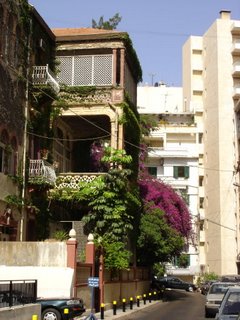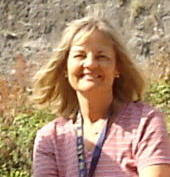Before we left for dinner, they showed us pictures on their computer that they had taken immediately following the Hariri bombing of last year. To remind you, or inform you, Rafiq Hariri, the prime minister of Lebanon and a moderate, was driving with his bodyguards past the St. George Hotel when his motorcade was blown to smitherines by a huge bomb. The occurance has been under investigation ever since. Currently, there is a temporary building constructed over the site of the explosion. The hotel stands eerily vacant. The high-rise building across the street bends forward with its twisted metal support beams stretching upward and outward. The top two floors were melted by the impact of the explosion. Imagine how high the flames must have reached to demolish the top of the building. Authorities are still trying to determine the dynamics of the incident. Speculation says that explosives may have been placed under ground, or packed into some of the plastic barriers that lined the street. Maybe it was both. The cell phone guys said that they saw some road work being done in the dead of night before the bombing. In the morning, the workers were gone. They thought that was odd.
Anyway, because the cellphone shop is just behind the street where the bombing occurred, they suffered extensive damage to the store. The windows imploded and everything was destroyed. The cellphone guys ran over to the scene and took pictures (with their cellphones, of course!) even before the police showed up, so they had photos that were more immediate and more horrific than anything portrayed in the media. They even had a video and I won't go into detail about it here, but it was chilling to watch.
We left for dinner in a couple of cars driven by the cellphone guys. They took us into the new downtown area that was heavily damaged during the civil war. Buildings are going up right and left, and others are being repaired. It seems that the architects around here are being quite intelligent about their choice of style. Everything blends in nicely with what's here. In Cyprus, unimaginative, block-like buildings appear to be plunked down in the middle of lots with no thought for esthetics. They could learn something from the Lebanese architects.
We parked and walked to an area that is inaccessible to cars. Cafés have been set up between buildings and creative lighting on the façades exuded a warm glow. As we walked down to the main square where the parliament building is and where a brand new, Turkish style mosque has been constructed, a call to prayer rang out, hauntingly between the buildings. It only added to the atmosphere.
Behind the new mosque, a temporary memorial to Hariri has been errected. His body and that of his guards is draped with white flowers and pictures of him have been placed all around. People come here to pay their respects. I saw a scarved, Moslem woman weeping softly as she dabbed her eyes and walked from casket to casket. Hariri's death was a great loss for this country.
We had a light, Lebanese meze at one of the cafes. The cellphone guys rented hookahs filled with fruity smelling tobacco. We had a lovely time, after which, Walid, the repair guy, drove us back to our hotel. A nice taste of modern Lebanon.
****************************************************
Related article on AFP (Yahoo) 6/17/06
Beirut Property Boom Ignores Political Crisis
Despite Lebanon's deep economic and political crises, an unprecedented property boom has turned Beirut into a giant building site, spurred by the appetite of developers, expatriates, and Gulf Arabs.
Bulldozers and giant cranes have invaded the capital, where any vacant lot or damaged building triggers fierce battles among property developers, who are mostly building residential apartments too expensive for the average citizen.
The boom started last year despite dramatic events that shook the country, and which turned on the assassination of former premier Rafiq Hariri, with property prices soaring an average of 50 percent.
Beirut has witnessed a major face-lift with the new construction boom, mostly in the once war-ravaged downtown area being rebuilt by the private company Solidere, which runs properties valued at about five billion dollars.
Brand new residential high-rises financed by Lebanese and Gulf investors now tower over the marina near Seafront Road where Hariri was killed in a massive car bombing in February 2005.
"Very often, when the first picks strike the ground at the construction sites, between 75 and 80 percent of these projects are already sold to rich Lebanese or Arab nationals," Raja Makerem, manager of Ramco realty, told AFP.
Victor Najarian, director general of CARE realty, said "We are managing about 15 projects worth a total value of one billion dollars, and we hope to double that amount within a year."
Along the downtown seafront area, apartments run at between 600 and 1,000 square meters (6,450-10,765 square feet) and sell at 5,000-6,000 dollars per square meter.
About 60 percent of the apartments sold in the area have been bought by Gulf Arabs and the rest mostly by wealthy Lebanese.
Relatively smaller apartments in the downtown area sell at 3,400-4,500 dollars per square meter.
"And Lebanon can still expect more, as it has great potential in the five years to come," Najarian said. He noted that five luxury hotels and a dozen large projects were underway along the seafront, where about 30 more projects are due to be launched.
Solidere sold land worth a total of 1.1 billion dollars in the first quarter of 2006, five times more than in all of last year, Makarem said.
The latest Ramco report said "Gulf investors may have propped up Lebanon's balance of payments with more than one billion dollars during 2005 alone. Additional spending on construction and furnishing could more than double that amount."
Gross foreign capital inflow reached 3.9 billion dollars in the first four months of this year, increasing the balance of payments surplus to 1.4 billion dollars, according to figures from the Central Bank of London.
According to the Ramco report, the total area of land bought by Gulf Arabs across Lebanon multiplied by four times to two million square meters between 2002 and 2005.
But the boom has raised concerns for the country's architectural heritage.
"In the 1990's, about 2,200 traditional buildings were registered in Beirut. Today, only a quarter of that has remained," architect Jacques Ligier Belair told AFP.
Perched on a hill facing the Mediterranean, the once quiet residential neighborhood of Ashrafiyeh with its old, elegant buildings has dramatically changed in the past few years. Restaurants, bars, trendy shops and new buildings have mushroomed across the neighborhood where prices have sky-rocketed.
"Two years ago, apartments were selling at a maximum of 1,100 dollars per square meter. Today, they start at 1,600 dollars," said Ligier Belair.
*******************************************************************
New apartment building near ACS.

The Old and The New(er).

.jpg)
3 comments:
I read your blog with interest. I wonder if two of the other people you mention are Gail and Lynn Hill. I knew them and Mary Louise Kelberer when I was very young, 4th
grade I believe, in Beirut. I too returned to Beirut but in 2004 and also walked through ACS, AUB campus, I went to Byblos, Tripoli as well. If they are gail and lynn hill please say hello from me.Barbara Burnett- Farley
Thanks, Barbara. Do you have an e-mail address I could pass along?
Lisa (Dr. Aphrodite)
Post a Comment